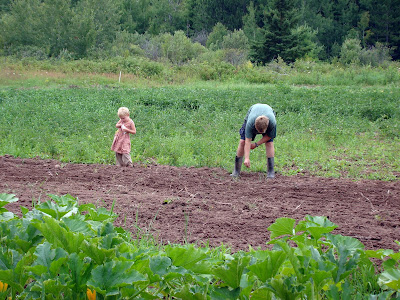Fall is here.
 |
| Note Scott's hunter orange cap. A sure sign of fall. |
This final harvest is turning out to be a bit of a whirlwind for us. We've shifted the pick-up so that we will be able to attend a family wedding this Friday (thank you once again for letting us make this change!!), which means we need to have shares ready for all seventy five members this Wednesday, rather than spreading the harvest between Wednesday and Saturday pick-ups as we usually would. So, we've attempted to spread the harvest between three days.
We did take time out yesterday to catch this seventeen and a half inch brown trout though:
 |
| This was totally all Scott. I had nothing to do with catching this fish. I was downstream, most likely disentangling my line from something. |
 |
| We got through carrots (you each get three pounds this week) |
 |
| And about half of the beets (you get one pound this week) |
The beets gave us some trouble this year. Remember way back in the spring when it was very wet? That happened just after we planted the beets, in an ever so slightly low area of the garden. Long story short, we have smaller than normal beets this year. So a pound of beets is actually several beets, but they are little. We had hoped to have 2 or 3 pounds for everyone. Enough to make it worth breaking out the canner. If you are determined to have pickled beets, this is the recipe we use: http://www.pickyourown.org/pickledbeets.htm. At least you won't have to chop them up!
In addition to carrots and beets, everyone can expect to receive: Tomatoes, Scallions, Onion, Celeriac, Gold Ball Turnips or Winter Radishes, Daikon, Brussels Sprouts, Winter Squash, Rutabaga or Cabbage, Kale or Chard, Fall Salad Mix, and Parsley or Sorrel or Basil.
If you don't know or have forgotten, be sure to roast your Brussels Sprouts. Drizzle them with a little olive oil and chopped garlic (and balsamic vinegar if you are fancy) before roasting them in a single layer at 400 degrees until they are just starting to brown. Roasting makes Brussels Sprouts delicious. Boiling them does not.
You should also try mashing your root vegetables.
Root Vegetable Puree
A simple and delicious fall side dish. If you remove all of the greens and keep the veggies in your crisper (or another cold, high humidity environment), all of the items that go into this dish will easily keep until Thanksgiving, though this recipe only makes enough to serve four. Throw in some potatoes (boil them with the other veggies) or roasted squash if you want to bulk it up. Also, drink a bit of the cooking liquid. It's tasty. Seda tasted some from my glass and said "Mama, did you make a special vegetable tea?" before requesting a glass of her own.
- One large or two small Rutabaga, peeled and chopped roughly
- Two large Carrots, peeled and chopped roughly
- Three very small (or one large) Celeriac, peeled and chopped roughly
- Salt
- Butter (about a tablespoon)
- A handful of Celeriac leaves, if you still have them, chopped
Bring a large pot of lightly salted water to a boil. Add the vegetables (but not the celeriac leaves) and boil until they are all tender enough to easily pierce with a fork. Do not over boil or you will have a mushy, watery, mess. It shouldn't take more than 20 minutes.
Remove the vegetables from the cooking water. Reserve the water for another use (special vegetable tea...soup stock). You will want a small amount of the cooking liquid for the next step.
Puree the vegetables with your favorite pureeing device (by now you all know how much I enjoy my immersion blender), adding a bit of the cooking liquid if needed to make a smooth puree.
While it is still hot, stir in butter and a handful of chopped celeriac leaves.
 |
| Before you stir, it will look like this. Assuming it is dark out and your kitchen is not well lit. |
















































